Building a Road to Fort Atkinson on the West Bank of the Mississippi River in the Summer of 1841.
Constructed as a buffer between rival Indian Nations in Wisconsin Territory (later Iowa), the present document tells a portion of the story of the construction of the road between the west bank of the Mississippi River (opposite Prairie du Chien and Fort Crawford) and Fort Atkinson.
Ironically, the muster shows that it was not civilian labor which built the road, as reported in most accounts of this chapter of history, but was in fact off duty non-commissioned officers and enlisted personnel, who undertook the labor for extra pay.
The present document identifies the names and ranks of 78 men who participated in the construction of the road, along with their rank, the number days worked and pay amount. A second note at the center states:
By order of Bt. Brigr. Genl. Geo. M. Brooke U.S. Army. N.C. Officers, Superintending Small [Groups?] of [ ? ] + Privates, in detached Parties, constructing a Public road, landing from the West bank of the Mississippi towards Fort Atkinson
The muster is quite likely in the hand of Captain Isaac Lynde, who was the commanding officer of the small initial force at Camp Atkinson and whose contemporary correspondence with General Henry Atkinson, his commanding officer, is reported elsewhere. In May 1840, Captain Lynde led an company of infantry from Ft. Crawford on the Mississippi River west into Iowa, to construct what would come to be known as Camp Atkinson (later Fort Atkinson). The following summer, in order to expand the camp, a road was constructed from the Mississippi River to Camp Atkinson in order to transport construction materials in aid of the effort to expand the fort.
Ironically, it was the cost of this road and related construction which would draw significant criticism the following year from Atkinson's superiors.
Camp / Fort Atkinson (1840-1849)
In 1840, the Winnebago Indians were removed to their new home on the Neutral Ground. In order to protect them from the incursions of their neighbors, among whom were the Sauk and Fox tribes, and from intrusions of the whites, and to prevent the Winnebagos from trespassing beyond the limits of the reservation, soldiers were stationed among them.
A detachment of the 5th Infantry (Company F) under command of Captain Isaac Lynde left Fort Crawford, with a complement of 82 officers and enlisted men, and went into camp, May 31, 1840, in the neighborhood of Spring creek (now known as Goddard’s creek) on the Turkey River. The camp was named “Camp Atkinson” in honor of Brigadier General Henry Atkinson, U. S. Army, the Department Commander in the upper Mississippi valley. Barrack and quarters sufficient to accommodate one company were erected, and in March, 1841, the Secretary of War ordered that the station be known as Fort Atkinson. In April, 1841, Atkinson received orders to station a company of dragoons in the Neutral Cround with orders to patrol the area between the Winnebago and Sac-Fox tribes.
As noted in the Annals of Iowa, page 594.
With the addition of the dragoons to the garrison the temporary quarters at Camp Atkinson were inadequate. In 1841, Atkinson received authorization to expand the facilities at the camp. . . . To bring lumber, stone, door and window fixtures, and furnishings to the new fort, a wagon road was built extending from the west shore of the Mississippi River across from Prairie du Chien to the camp nearly forty miles into Iowa. Soon sturdy stone and plank barracks and stables replaced the temporary log buildings erected only a year earlier. That summer the post was renamed Fort Atkinson. . . .
When he had suggested the post in the spring of 1840, General Atkinson had envisioned a few temporary buildings which could be erected by the troops and would be only a minor expense to the government. By 1842, however, the expense of building the road, erecting permanent facilities, and having much of the work done by paid civilian laborers raised the costs far beyond earlier expectations. Inspector General George Croghan, after visiting Fort Atkinson on his 1842 tour of inspection, was most unhappy. "Twenty-eight thousand dollars and more have already been expended upon this post," he complained, "nearly fourteen thousand beyond the amount appropriated by Congress, and five thousand dollars more are wanted to complete the work ... . No temporary work such as this ought to be, should eost more than five hundred dollars, or require a longer time than a month in its erection."
When completed in 1842, the post had some 24 buildings inside a stockade wall and 14 outside.
The infantry garrison was supplemented by a company of Dragoons on June 24, 1841 and later by volunteer troops during the Mexican War (1846-1848). The fort was abandoned on February 24, 1849 when the Winnebago were moved to a new reservation in Minnesota.











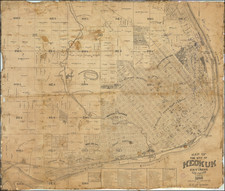
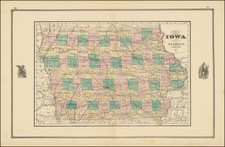
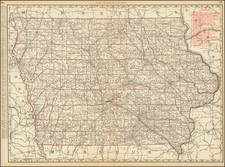
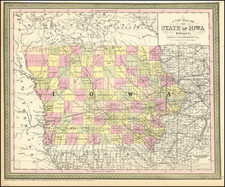
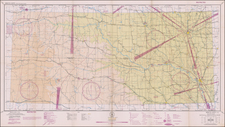
![Map of the Surveyed Part of Iowa Exhibiting the Sections, Townships & Ranges [with book] Iowa with Topographic Map From the U.S. Surveys](https://storage.googleapis.com/raremaps/img/small/86978.jpg)